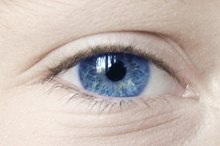Retinal detachment is a condition where the back of your retina separates from the underlying layers of the eyeball. This separation detaches the retinal tissue from the blood vessels, which then deprives the retina of blood, oxygen and other nutrients. Treatment usually involves retinal detachment surgery, in which your surgeon reattaches the torn or severed tissue. As with almost any surgical procedure, you must restrict physical activity during your recovery -- the length of time is often based on the progress of healing.
Timing
Although everyone responds differently to treatment, it usually takes upward of two months to ensure the retina has been successfully treated, according to the Midland Eye Institute. For the first few weeks of this recovery period, avoid heavy physical activity, including more vigorous athletic pursuits. As soon as your doctor gives you the go-ahead, however, you can return to your regular workout routine.
- Although everyone responds differently to treatment, it usually takes upward of two months to ensure the retina has been successfully treated, according to the Midland Eye Institute.
- As soon as your doctor gives you the go-ahead, however, you can return to your regular workout routine.
Effects
Exercise & Posterior Vitreous Detachment
Learn More
The reason for this restriction is directly related to concerns that the retina remains attached after the procedure. Exercise is known to change the intraocular pressure of the eyes 2. Systolic blood pressure tends to increase, while diastolic blood pressure often decreases with physical activity, notes a study conducted by the Department of Ophthalmology at the Washington University School of Medicine. Any changes in pressure — as is seen from vigorous or strenuous pursuits — can sometimes lead to detachment.
- The reason for this restriction is directly related to concerns that the retina remains attached after the procedure.
- Systolic blood pressure tends to increase, while diastolic blood pressure often decreases with physical activity, notes a study conducted by the Department of Ophthalmology at the Washington University School of Medicine.
Symptoms
If you return to exercise before your doctor gives you the okay, and it results in detachment, you’ll likely experience some of the same symptoms you did prior to the surgical procedure. One of the most common symptoms is floaters, which appear as small spots or strings that float through your line of vision. These floaters are often accompanied by sudden flashes of light and reduced vision over a portion of your visual field.
Treatment
What Causes Light Flashes in the Eye?
Learn More
As soon as you experience these symptoms, contact your doctor. The longer you leave the condition untreated, the more likely you’ll suffer from vision loss. The detachment is depriving the retina of oxygen. As with any other bodily tissue, the lack of oxygen can result in tissue death.
- As soon as you experience these symptoms, contact your doctor.
- As with any other bodily tissue, the lack of oxygen can result in tissue death.
Related Articles
References
- MayoClinic.com; Retinal Detachment; November 2010
- Investigative Ophthalmology and Visual Science; The Effect of Exercise on Intraocular Pressure; Daniel Marcus, et al.; October 1970
- Feltgen N, Walter P. Rhegmatogenous retinal detachment--an ophthalmologic emergency. Dtsch Arztebl Int. 2014;111(1-2):12-21. doi:10.3238/arztebl.2014.0012
- Amer R, Nalcı H, Yalçındağ N. Exudative retinal detachment. Surv Ophthalmol. 2017;62(6):723-769. doi:10.1016/j.survophthal.2017.05.001
- Williams GA. How common is it to get retinal detachments in both eyes? American Academy of Ophthalmology. Nov 18, 2018.
- American Academy of Opthalmology. Retinal Detachment: Torn or Detached Retina Symptoms. Updated March 1, 2016.
- Retinal Detachment: Torn or Detached Retina Symptoms. American Academy of Ophthalmology. Jan 24, 2018.
- Nentwich MM, Ulbig MW. Diabetic retinopathy - ocular complications of diabetes mellitus. World J Diabetes. 2015;6(3):489-99. doi:10.4239/wjd.v6.i3.489
- Retinal Detachment. National Eye Institute. Jun 2019.
- Kriebel D, Sama SR, Bradbury M, et al. Risk Factors for Retinal Detachment: A Case-Control Study. J Occup Environ Med. 2020;62(6):445-451.doi:10.1097/JOM.0000000000001867
- Josifovska N, Lumi X, Szatmari-Tóth M, Kristóf E, Russell G, Nagymihály R et al. Clinical and molecular markers in retinal detachment-From hyperreflective points to stem cells and inflammation.PLoS One. 2019 Jun 11;14(6):e0217548. doi:10.1371/journal.pone.0217548. eCollection 2019.
- Lee EK, Yu HG.Outcomes of Anti-vascular Endothelial Growth Factor Treatment for Foveal Serous Retinal Detachment Associated with Inferior Staphyloma.Korean J Ophthalmol. 2019 Jun;33(3):228-237. doi:10.3341/kjo.2018.0125.
Writer Bio
Based in Minneapolis, Minn., Dana Severson has been writing marketing materials for small-to-mid-sized businesses since 2005. Prior to this, Severson worked as a manager of business development for a marketing company, developing targeted marketing campaigns for Big G, Betty Crocker and Pillsbury, among others.








